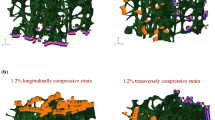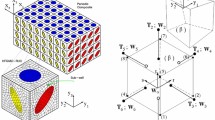Abstract
Trabecular bone has a complicated porous microstructure and consists of interconnected plates and rods known as trabeculae. The microarchitecture of the trabeculae contributes to load distribution capacity and, particularly, the optimal bone strength. Many previous studies have shown that morphological parameters are used to characterize the microarchitecture of trabecular bone, but little is known about the mechanical role of trabecular morphology in the context of load-bearing behavior. Therefore, this study proposes a new segmentation method for examining the morphology of trabecular structure foci of load-bearing capability. A micro-finite element model of trabecular bone was obtained from the fourth lumbar vertebra on the basis of a three-dimensionally reconstructed micro-computed tomography (CT) image. We used an asymptotic homogenization method to determine microscopic stress by applying three unidirectional compressive loads in the vertical, anteroposterior, and right–left axes of two trabecular bone volumes. We then classified the complicated trabecular microstructure into three segments: primary and secondary trabeculae and trabeculae of no contribution. Next, a dynamic analysis was conducted by applying a force impulse load. The result indicated that 1/3 of the trabecular volume functions as primary trabecula. The morphology of the trabecular network could be visualized successfully highlighting the percolation of the stress wave in the primary trabecular segment. Further, we found that the role of the plate-like structures was that of a hub in the trabecular network system.









Similar content being viewed by others
References
Blain H, Chavassieux P, Portero-Muzy N, Bonnel F, Canovas F, Chammas M, Maury P, Delmas PD (2008) Cortical and trabecular bone distribution in the femoral neck in osteoporosis and osteoarthritis. Bone 43:862–868
Dalle Carbonare L, Valenti MT, Bertoldo F, Zanatta M, Zenari S, Realdi G, Lo Cascio V, Giannini S (2005) Bone microarchitecture evaluated by histomorphometry. Micron. 36:609–616
Gefen A (2009) Finite element modeling of the microarchitecture of cancellous bone: techniques and applications. In: Leondes CT (ed) Biomechanical systems technology: muscular skeletal systems. World Scientific, Singapore, pp 73–112
Guedes J, Kikuchi N (1990) Preprocessing and postprocessing for materials based on the homogenization method with adaptive finite element methods. Comput Methods Appl Mech Eng 83:143–198
Guo XE (2001) Mechanical properties of cortical bone and cancellous bone tissue. In: Cowin SC (ed) Bone mechanics handbook. CRC Press, Boca Raton
Haïat G, Padilla F, Peyrin F, Laugier P (2007) Variation of ultrasonic parameters with microstructure and material properties of trabecular bone: a 3D model simulation. J Bone Miner Res 22:665–674
Hamed E, Lee Y, Jasiuk I (2010) Multiscale modeling of elastic properties of cortical bone. Acta Mech 213:131–154
Hollister SJ, Kikuchi N (1994) Homogenization theory and digital imaging: a basis for studying the mechanics and design principles of bone tissue. Biotechnol Bioeng 43:586–596
Hollister SJ, Fyhrie DP, Jepsen KJ, Goldstein SA (1991) Application of homogenization theory to the study of trabecular bone mechanics. J Biomech 24:825–839
Hollister SJ, Brennan JM, Kikuchi N (1994) A homogenization sampling procedure for calculating trabecular bone effective stiffness and tissue level stress. J Biomech 27:433–444
Homminga J, Weinans H, Gowin W, Felsenberg D, Huiskes R (2001) Osteoporosis changes the amount of vertebral trabecular bone at risk of fracture but not the vertebral load distribution. Spine. 26:1555–1561
Homminga J, Van-Rietbergen B, Lochmüller EM, Weinans H, Eckstein F, Huiskes R (2004) The osteoporotic vertebral structure is well adapted to the loads of daily life, but not to infrequent “error” loads. Bone 34:510–516
Hosokawa A (2008) Development of a numerical cancellous bone model for finite-difference time-domain simulations of ultrasound propagation. IEEE Trans Ultrason Ferroelectr Freq Control 55:1219–1233
Hosokawa A (2009) Numerical analysis of variability in ultrasound propagation properties induced by trabecular microstructure in cancellous bone. IEEE Trans Ultrason Ferroelectr Freq Control 56:738–747
Jaasma MJ, Bayraktar HH, Niebur GL, Keaveny TM (2002) Biomechanical effects of intraspecimen variations in tissue modulus for trabecular bone. J Biomech 35:237–246
Judex S, Boyd S, Qin Y-X, Miller L, Müller R, Rubin C (2003) Combining high-resolution micro-computed tomography with material composition to define the quality of bone tissue. Current Osteoporos Rep. 1:11–19
Kameo Y, Adachi T, Hojo M (2011) Effects of loading frequency on the functional adaptation of trabeculae predicted by bone remodeling simulation. J Mech Behav Biomed Mater 4:900–908
Kinney JH, Ladd AJC (1998) The relationship between three-dimensional connectivity and the elastic properties of trabecular bone. J Bone Miner Res 13:839–845
Kosturski N, Margenov S (2010) Numerical homogenization of bone microstructure. In: Lirkov I, Margenov S, Wasniewski J (eds) Large-scale scientific computing. Springer, Berlin, pp 140–147
Kuhlemeyer RL, Lysmer J (1973) Finite element method accuracy for wave propagation problems. J Soil Mech Found Div Proc Am Soc Civ Eng 99:421–427
Lewy H, Friedrichs K, Courant R (1967) On the partial difference equations of mathematical physics. IBM J Res Dev 11:215–234
Liu XS, Sajda P, Saha PK, Wehrli FW, Bevill G, Keaveny TM, Guo XE (2008) Complete volumetric decomposition of individual trabecular plates and rods and its morphological correlations with anisotropic elastic moduli in human trabecular bone. J Bone Miner Res 23:223–235
Liu XS, Huang AH, Zhang XH, Sajda P, Ji B, Guo XE (2008) Dynamic simulation of three dimensional architectural and mechanical alterations in human trabecular bone during menopause. Bone 43:292–301
Lysmer J, Kuhlemeyer RL (1969) Finite dynamic model for infinite media. J Eng Mech Div Proc Am Soc Civ Eng. 95:859–877
Majumdar S, Kothari M, Augat P, Newitt DC, Link TM, Lin JC, Lang T, Lu Y, Genant HK (1998) High-resolution magnetic resonance imaging: three-dimensional trabecular bone architecture and biomechanical properties. Bone 22:445–454
Mosekilde L (1993) Vertebral structure and strength in vivo and in vitro. Calcif Tissue Int 53:S121–S126
Müller R, Hildebrand T, Rüegsegger P (1994) Non-invasive bone biopsy: a new method to analyse and display the three-dimensional structure of trabecular bone. Phys Med Biol 39:145–164
Padilla F, Bossy E, Haiat G, Jenson F, Laugier P (2006) Numerical simulation of wave propagation in cancellous bone. Ultrasonics 44(Suppl 1):e239–e243
Parnell WJ, Grimal Q, Abrahams ID, Laugier P (2006) Modelling cortical bone using the method of asymptotic homogenization. J Biomech 39:S20
Pothuaud L, Porion P, Lespessailles E, Benhamou CL, Levitz P (2000) A new method for three-dimensional skeleton graph analysis of porous media: application to trabecular bone microarchitecture. J Microsc 199:149–161
Pothuaud L, Laib A, Levitz P, Benhamou CL, Majumdar S (2002) Three-dimensional-line skeleton graph analysis of high-resolution magnetic resonance images: a validation study from 34-microm-resolution microcomputed tomography. J Bone Miner Res 17:1883–1895
Rho JY, Ashman RB, Turner CH (1993) Young’s modulus of trabecular and cortical bone material: ultrasonic and microtensile measurements. J Biomech 26:111–119
Sanchez-Palencia E (1980) Non-homogenous media and vibration theory. Springer, Berlin
Shi X, Wang X, Niebur G (2009) Effects of loading orientation on the morphology of the predicted yielded regions in trabecular bone. Ann Biomed Eng 37:354–362
Shi X, Liu XS, Wang X, Guo XE, Niebur GL (2010) Effects of trabecular type and orientation on microdamage susceptibility in trabecular bone. Bone 46:1260–1266
Siffert RS, Luo GM, Cowin SC, Kaufman JJ (1996) Dynamic relationships of trabecular bone density, architecture, and strength in a computational model of osteopenia. Bone 18:197–206
Stauber M, Müller R (2006) Volumetric spatial decomposition of trabecular bone into rods and plates—a new method for local bone morphometry. Bone 38:475–484
Syahrom A, Abdul Kadir MR, Abdullah J, Ochsner A (2011) Mechanical and microarchitectural analyses of cancellous bone through experiment and computer simulation. Med Biol Eng Comput 49:1393–1403
Takano N, Zako M, Kubo F, Kimura K (2003) Microstructure-based stress analysis and evaluation for porous ceramics by homogenization method with digital image-based modeling. Int J Solids Struct 40:1225–1242
Takano N, Fukasawa K, Nishiyabu K (2010) Structural strength prediction for porous titanium based on micro-stress concentration by micro-CT image-based multiscale simulation. Int J Mech Sci 52:229–235
van der Linden JC, Birkenhäger-Frenkel DH, Verhaar JAN, Weinans H (2001) Trabecular bone’s mechanical properties are affected by its non-uniform mineral distribution. J Biomech 34:1573–1580
Weinans H, Huiskes R, Grootenboer HJ (1992) The behavior of adaptive bone-remodeling simulation models. J Biomech 25:1425–1441
Acknowledgments
The authors would like to thank Prof. Yuji Nakajima and Prof. Hiroshi Kiyama (Osaka City University) for providing the bone specimen. The Ethics Committee approved the analysis of this bone specimen. We also wish to thank the donor’s family for their generosity in the face of their bereavement. Further, the dedicated help from Dr. Takuya Ishimoto and Dr. Sayaka Miyabe (both Osaka University) in preparing the micro-CT images for this research is acknowledged with gratitude.
Author information
Authors and Affiliations
Corresponding author
Rights and permissions
About this article
Cite this article
Basaruddin, K.S., Takano, N., Yoshiwara, Y. et al. Morphology analysis of vertebral trabecular bone under dynamic loading based on multi-scale theory. Med Biol Eng Comput 50, 1091–1103 (2012). https://doi.org/10.1007/s11517-012-0951-3
Received:
Accepted:
Published:
Issue Date:
DOI: https://doi.org/10.1007/s11517-012-0951-3




